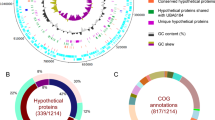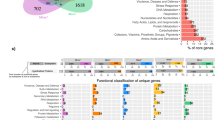Abstract
Bacteria living within eukaryotic cells can be essential for the survival or reproduction of the host1,2 but in other cases are among the most successful pathogens3,4. Environmental Chlamydiae, including strain UWE25, thrive as obligate intracellular symbionts within protozoa; are recently discovered relatives of major bacterial pathogens of humans; and also infect human cells4,5,6,7. Genome analysis of UWE25 predicted that this symbiont is unable to synthesize the universal electron carrier nicotinamide adenine dinucleotide (NAD+)7. Compensation of limited biosynthetic capacity in intracellular bacteria is usually achieved by import of primary metabolites8,9,10,11. Here, we report the identification of a candidate transporter protein from UWE25 that is highly specific for import of NAD+ when synthesized heterologously in Escherichia coli. The discovery of this candidate NAD+/ADP exchanger demonstrates that intact NAD+ molecules can be transported through cytoplasmic membranes. This protein acts together with a newly discovered nucleotide transporter and an ATP/ADP translocase12, and allows UWE25 to exploit its host cell by means of a sophisticated metabolic parasitism.
This is a preview of subscription content, access via your institution
Access options
Subscribe to this journal
Receive 51 print issues and online access
$199.00 per year
only $3.90 per issue
Buy this article
- Purchase on Springer Link
- Instant access to full article PDF
Prices may be subject to local taxes which are calculated during checkout




Similar content being viewed by others
References
Baumann, P. et al. Genetics, physiology, and evolutionary relationships of the genus Buchnera: intracellular symbionts of aphids. Annu. Rev. Microbiol. 49, 55–94 (1995)
Charlat, S., Hurst, G. D. & Mercot, H. Evolutionary consequences of Wolbachia infections. Trends Genet. 19, 217–223 (2003)
Cossart, P. & Sansonetti, P. J. Bacterial invasion: the paradigms of enteroinvasive pathogens. Science 304, 242–248 (2004)
Mahoney, J. B., Coombes, B. K. & Chernesky, M. A. in Manual of Clinical Microbiology (ed. Murray, P. R.) 991–1004 (ASM, Washington DC, 2003)
Fritsche, T. R., Horn, M., Wagner, M., Herwig, K.-H. & Schleifer, K.-H. Phylogenetic diversity among geographically dispersed Chlamydiales endosymbionts recovered from clinical and environmental isolates of Acanthamoeba spp. Appl. Environ. Microbiol. 66, 2613–2619 (2000)
Greub, G., Mege, J.-L. & Raoult, D. Parachlamydia acanthamoeba enters and multiplies within human macrophages and induces their apoptosis. Infect. Immun. 71, 5979–5985 (2003)
Horn, M. et al. Illuminating the evolutionary history of chlamydiae. Science 304, 728–730 (2004)
Moulder, J. M. The Biochemistry of Intracellular Parasitism (Univ. Chicago Press, Chicago, Illinois, 1962)
Winkler, H. H. Rickettsial permeability: an ADP-ATP transport system. J. Biol. Chem. 251, 389–396 (1976)
Hatch, T. P., Al-Hossainy, E. & Silverman, J. A. Adenine nucleotide and lysine transport in Chlamydia psittaci. J. Bacteriol. 150, 662–670 (1982)
Atkinson, W. H. & Winkler, H. H. Permeability of Rickettsia prowazekii to NAD. J. Bacteriol. 171, 761–766 (1989)
Schmitz-Esser, S. et al. ATP/ADP translocases: a common feature of obligate intracellular amoebal symbionts related to chlamydia and rickettsia. J. Bacteriol. 186, 683–691 (2004)
Winkler, H. H. & Neuhaus, H. E. Non-mitochondrial ATP transport. Trends Biochem. Sci. 24, 64–68 (1999)
Tjaden, J. et al. Two nucleotide transport proteins in Chlamydia trachomatis, one for net nucleoside triphosphate uptake and the other for the transport of energy. J. Bacteriol. 181, 1196–1202 (1999)
Krause, D. C., Winkler, H. H. & Wood, D. O. Cloning and expression of the Rickettsia prowazekii ADP/ATP translocator in Escherichia coli. Proc. Natl Acad. Sci. USA 82, 3015–3019 (1985)
Tjaden, J., Schwöppe, C., Möhlmann, T. & Neuhaus, H. E. Expression of the plastidic ATP/ADP transporter gene in Escherichia coli leads to a functional adenine nucleotide transport system in the bacterial cytoplasmic membrane. J. Biol. Chem. 273, 9630–9636 (1998)
Möhlmann, T. et al. Occurrence of two plastidic ATP/ADP transporters in Arabidopsis thaliana L. Molecular characterisation and comparative structural analysis of similar ATP/ADP translocators from plastids and Rickettsia prowazekii. Eur. J. Biochem. 252, 353–359 (1998)
Linka, N. et al. Phylogenetic relationship of non-mitochondrial nucleotide transport proteins in bacteria and eukaryotes. Gene 306, 27–35 (2003)
Trentmann, O., Decker, C., Winkler, H. H. & Neuhaus, H. E. Charged amino-acid residues in transmembrane domains of the plastidic ATP/ADP transporter from Arabidopsis are important for transport efficiency, substrate specificity, and counter exchange properties. Eur. J. Biochem. 267, 4098–4105 (2000)
Zhang, Q., Piston, D. W. & Goodman, R. H. Regulation of corepressor function by nuclear NADH. Science 295, 1895–1897 (2002)
Coffe, V., Carbajal, R. C. & Salceda, R. Glycogen metabolism in the rat retina. J. Neurobiol. 88, 885–890 (2004)
Saier, M. H. A functional-phylogenetic classification system for transmembrane solute transporters. Microbiol. Mol. Biol. Rev. 64, 345–411 (2000)
Hofmann, K. & Stoffel, W. TMbase—A database of membrane spanning protein segments. Biol. Chem. 374, 166–172 (1993)
Thompson, J. D., Gibson, D. J., Plewniak, F., Jeanmougin, F. & Higgins, D. G. The CLUSTAL_X windows interface: flexible strategies for multiple sequence alignment aided by quality analysis tools. Nucleic Acids Res. 25, 4876–4882 (1997)
Ludwig, W. et al. ARB: a software environment for sequence data. Nucleic Acids Res. 32, 1363–1371 (2004)
Gautom, R. K. & Fritsche, T. R. Transmissibility of bacterial endosymbionts between isolates of Acanthamoeba spp. J. Euk. Microbiol. 42, 452–456 (1995)
Mangold, H. K. in Dünnschicht-Chromatographie. Ein Laboratoriumshandbuch (ed. Stahl, E.) 749–769 (Springer, Heidelberg, 1967)
Acknowledgements
Work in the laboratory of H.E.N. was supported by the DFG and the local research centre ‘Neue Wirkstoffe’, funded by the Federal State Rheinland-Pfalz. Work in the laboratory of M.W. was supported by the Austrian Science Fund (FWF) and by the Austrian Federal Ministry for Education, Science and Culture in the context of the GEN-AU project ‘Environmental Chlamydia Proteomics’.
Author information
Authors and Affiliations
Corresponding author
Ethics declarations
Competing interests
The authors declare that they have no competing financial interests.
Supplementary information
Supplementary Data
This file contains Supplementary Table 1 (proteins with homology to the NAD+/ADP transporter NTT4 of UWE25 in the public databases EMBL/GenBank/DDBJ), Supplementary Figure 1 (amino-acid sequence alignment of various NTT-type proteins from intracellular bacteria and plants), Supplementary Figure 2 (Nucleotide transport catalyzed by NTT2 and NTT4), and Supplementary Figure 3 (Phylogenetic relationships of nucleotide transport proteins). (DOC 113 kb)
Rights and permissions
About this article
Cite this article
Haferkamp, I., Schmitz-Esser, S., Linka, N. et al. A candidate NAD+ transporter in an intracellular bacterial symbiont related to Chlamydiae. Nature 432, 622–625 (2004). https://doi.org/10.1038/nature03131
Received:
Accepted:
Issue Date:
DOI: https://doi.org/10.1038/nature03131
This article is cited by
-
Molecular and cellular characterization of four putative nucleotide transporters from the shrimp microsporidian Enterocytozoon hepatopenaei (EHP)
Scientific Reports (2023)
-
NAD+ metabolism is a key modulator of bacterial respiratory epithelial infections
Nature Communications (2023)
-
NAD+ metabolism: pathophysiologic mechanisms and therapeutic potential
Signal Transduction and Targeted Therapy (2020)
-
AXER is an ATP/ADP exchanger in the membrane of the endoplasmic reticulum
Nature Communications (2018)
-
Transporter gene acquisition and innovation in the evolution of Microsporidia intracellular parasites
Nature Communications (2018)
Comments
By submitting a comment you agree to abide by our Terms and Community Guidelines. If you find something abusive or that does not comply with our terms or guidelines please flag it as inappropriate.



